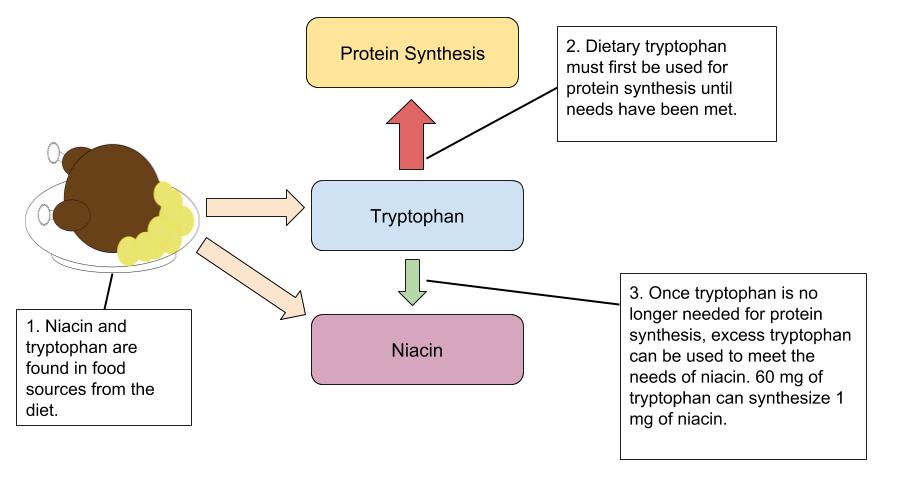Chapter 9. Micronutrients for Energy
Niacin (B3)
Role of Niacin (B3)
Niacin is a component of the coenzymes, NADH and NADPH, which are involved in the catabolism and/or anabolism of carbohydrates, lipids, and proteins. NADH is the predominant electron carrier and transfers electrons to the electron-transport chain to make ATP. NADPH is also required in the anabolic pathways of fatty acid and cholesterol synthesis. Niacin is also important in DNA replication, repair, and cell differentiation, as well as the production of hydrochloric acid.
In contrast to other vitamins, niacin can be synthesized by the human body from the amino acid tryptophan in an anabolic process requiring enzymes dependent on riboflavin, vitamin B6, and iron. Niacin is made from tryptophan only after tryptophan has met all of its other needs in the body. The contribution of tryptophan-derived niacin to niacin needs in the body varies widely and a few scientific studies have demonstrated that diets high in tryptophan have a negligible effect on niacin deficiency.

Dietary Reference Intakes for Niacin (B3)
The RDAs and ULs for different age groups for niacin are listed in the table below. Because niacin needs can be met from tryptophan, The RDA is expressed in niacin equivalents (NEs). The conversions of NE, niacin, and tryptophan are: 1 mg NE= 60 mg tryptophan= 1 mg niacin
| Age Group | RDA Females and Males mg NE/day) | UL |
| Infants (0–6 months) | 2 * | Not possible to establish |
| Infants (7–12 months) | 4* | Not possible to establish |
| Children (1–3 years) | 6 | 10 |
| Children (4–8 years) | 8 | 15 |
| Children (9–13 years) | 12 | 20 |
| Adolescents (14–18 years) | 14 (females), 16 (males) | 30 |
| Adults (> 19 years) | 14 (females), 16 (males) | 35 |
| *denotes Adequate Intake | ||
| Data Source: (“Niacin,” 2013)[1] | ||
Dietary Sources of Niacin (B3)
Niacin can be found in a variety of foods such as yeast, meat, poultry, red fish, and cereal. In plants, especially mature grains, niacin can be bound to sugar molecules, which can significantly decrease niacin bioavailability. For the niacin content of various foods, see the table below.
| Food | Serving | Niacin (mg) |
| Beef liver, pan fried, | 3 oz. | 14.9 |
| Chicken | 3 oz. | 7.3 |
| Tuna | 3 oz. | 8.6 |
| Turkey | 3 oz. | 10.0 |
| Salmon | 3 oz. | 8.5 |
| Beef (90% lean) | 3 oz. | 4.4 |
| Cereal (unfortified) | 1 c. | 5 |
| Cereal (fortified) | 1 c. | 20 |
| Peanuts | 1 oz. | 3.8 |
| Whole wheat bread | 1 slice | 1.3 |
| Coffee | 8 oz. | 0.5 |
| Data Source: (“Niacin,” 2013)[2] and Niacin, National Institute of Health [3] | ||
Consuming Too Little Niacin
Generally, Canadians consume enough niacin. However, pellagra results from a severe niacin deficiency. Symptoms of pellagra include changes in the gastrointestinal system that result in decreased hydrochloric acid production and decreased nutrient absorption. Other symptoms include fatigue, decreased appetite, and indigestion. These symptoms are then commonly followed by the four D’s: diarrhea, dermatitis, dementia, and sometimes death.

Consuming Too Much Niacin
There appear to be no side effects of consuming too much niacin from food, however, supplementation can result in toxicity. Such toxicity can result in burning, tingling, itching and flushing on the face, arms and chest. When very large doses are taken over long periods of time, liver damage, glucose intolerance, blurred vision, and edema of the eyes may occur. Based on this, the UL for adults over 19 years of age taking supplements is 35 mg/day.
- Micronutrient Information Center: Niacin. Oregon State University, Linus Pauling Institute. http://lpi.oregonstate.edu/mic/vitamins/niacin. Updated in July 2013. Accessed October 22, 2017. ↵
- Micronutrient Information Center: Niacin. Oregon State University, Linus Pauling Institute. http://lpi.oregonstate.edu/mic/vitamins/niacin. Updated in July 2013. Accessed October 22, 2017. ↵
- https://ods.od.nih.gov/factsheets/Niacin-HealthProfessional/ ↵

